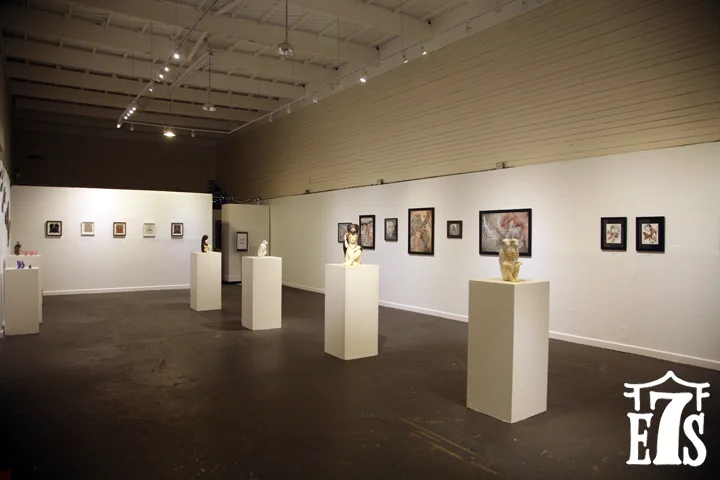June 2015 / Natural Selection
Candie Bolton, Caitlin Hackett, Crystal Morey, Bunnie Reiss, Roan Victor
Definition: "Natural Selection is the process by which forms of life having traits that better enable them to adapt to specific environmental pressures, as predators, changes in climate, or competition for food or mates, will tend to survive and reproduce in greater numbers than others of their kind, thus ensuring the perpetuation of those favorable traits in succeeding generations."
This exhibit showcases new works based on the relationship between humans and animals. Cohabitation is a necessity for the balance of wildlife and environmental sustainability. However, why are animals the ones forced to adjust to human civilization?
Artists
Candie Bolton
A self-taught artist and graphic designer from Sacramento, CA, Candie has been working as a graphic designer for the many years and began pursuing her art career since December 2013. “I’ve always felt that humans should find common ground with nature instead of distinguishing ourselves from it. For my pieces, I imagined a world where the lives of women and animals have been completely merged and exist harmoniously as one creature.”
Caitlin Hackett
“My passion for the natural world has inspired my art since I first put pencil to paper as child. I grew up on the northern coast of California, between the cold Pacific Ocean and the redwood forests. It was there that my love for nature and wilderness flourished. As I have grown I have combined my love for animals with my interest in both wildlife biology and mythology to create artwork that speaks to the current biological mythos that constructs the barrier between what is considered Human, and what is considered Animal. Mirroring ancient myths of transformation in often grotesque ways, we find in contemporary times that animals are being transformed biologically due to interactions with human pollutants; there are frogs with triplicate legs and blind eyes, cows with shriveled sets of legs growing out of their backs, two faced piglets being born on factory farms and radioactive fish rotting from the inside in poisoned seas, the list goes on. I am interested in the power of these mutations both for their mythological allusions as well as their dire environmental implications. I hope to remind those who view my artwork that we too are animals, embedded in this fragile world even as we poison it. My work alludes to the boundaries that separate humans from animals both physically and metaphysically, and the way in which these boundaries are warped by science, mythology, and religion alike. Like the gods of so many myths Humanity has warped the world into our own image, and it is this often frightening image I hope to reflect in my work.”
Crystal Morey
“I grew up in a small town in the Sierra Nevada foothills of Northern California. Living so close to nature filled my early years with an appreciation for the natural world and gave me an understanding of plant and animal life cycles. I spent my free time swimming in lakes and rivers, climbing trees, hiking in the snow, and exploring and building forts out in the forest. These early experiences filled my life with joy, imagination, and a tendency toward inward contemplation. I now live in Oakland, California and the urban landscape in my daily life is a stark contrast to the mountains and trees of my formative years. My experience of living in this place is what inspires my work today. I am interested in the intellectual, emotional and primal relationship between humans and their environment. My understanding of mans role in the environment has changed. I once saw humans as being under the umbrella of “nature,” subservient to natural happening. I now realize humans are the largest variable in the changing of our planet’s ecological and environmental outcome. We are living in an era of what has been called a “great acceleration,” and in the past one hundred years, humans have developed and changed the planet in a very drastic way. Through hunting, deforestation, ocean acidification, gene manipulation, industrial agriculture, and mountaintop removal, we are now the driving force behind environmental change. Today every human development has a reaction we can see and these actions are causing havoc, leading us to an unsustainable environment.”
Bunnie Reiss
An urban folk artist, Bunnie tells the stories of the things she sees, the things that seem important, and the things she finds in her travels and community. She is fearless in her making and wishes to create spaces where people feel safe and can imagine themselves into whoever they would like to be. “Our push/pull relationships with the beast is trapped in our worship of material objects. If we can let go of the object and return to nature, than we can honor both the spiritual and animal side to all of us. These gloves are a reminder of our spiritual self, our animal self, and the world that is constantly struggling to exist in both.” ‘We are not human beings having a spiritual experience. We are spiritual beings having a human experience.’ ~Pierre Teilhard de Chardin
Roan Victor
“I get tired of humans. And in all honesty, my fascination for animals (and plants alike) stem from a desire to know a world outside my own. I’m sure I’m not alone in this sentiment. Animals have been inspiration to classical and contemporary literature, mythology, movies and comic books (and movies from comic books). How are they like us? How are we like them? And just like that, we’re back to looking into ourselves, projecting only what we know. Like some nights, I wish to be a chameleon, happy to get lost in the background.”















































